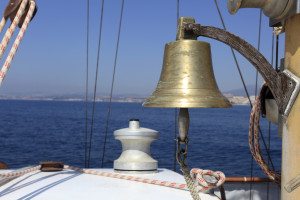Our last Carefree Boat Club training blog covered boating navigation rules. As a follow up, this week’s #TrainingThursday will cover the rules–and tools–of navigating a boat at night or in other poor visibility conditions. We will cover navigation lights, night navigation rules and sound signals.
Navigation Lights
To avoid other vessels at night, navigation lights are mounted to the port, starboard and top of the
mast to communicate your presence to other vessels. Sailing and powerboat vessels are both required to carry a green light on the port side, a red light on the port side and a white light from the stern side. In addition, powerboats are required to have a white masthead light depending on how tall they are. Some vessels also carry a yellow light for added visibility during the day time. Ships that are anchored only display one or two white lights depending on how big the vessel is.
Night Navigation Rules
It’s important to maintain a slower speed at night because speed affects your overall visibility! Location also plays an important factor in determining your speed and visibility; are you in a narrow channel or the wide open sea? According to Boating Magazine, radar and radio detection should be your eyes when you are blind. This means, the most reliable way to view your surroundings at night will be through radar.
Sound Signals
There are three types of sound blasts used to signal to other boaters in situations of poor visibility.
- One prolonged blast
- One short blast
- One stroke of the bell
According to BoatSafe.com, these sounds are used in conjunction with one another to produce these types of messages:
- “Power driven vessel making way.” One prolonged blast, every 2 minutes.
- “Vessel not under command, or inability to maneuver.” One prolonged, two short, every 2 minutes.
- “Power driven vessel underway but stopped and making no way.” Two prolonged blasts, every 2 minutes.
- “Vessel at anchor less than 100 meters.” 5 seconds of ringing a bell, every one minute.
- “Vessel aground less than 100 meters.” 3 bell strokes, 5 ringing a bell, 3 bell strokes, every minute.
Tune in to our next training blog on US Aids to Navigation Systems!
(Images and lessons sourced from Wikipedia, BoatingMag, BoatSafe.com)
For more information stay tuned to future posts and articles from Carefree Boat Club, or visit our social pages below!

